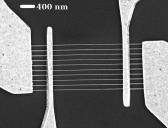
Georgia Tech is claiming 100MA/cm2 current densities for graphene interconnect.
Graphene, a single layer of graphite molecules discovered at the University of Manchester, is being touted both for future on-chip interconnect and super-fast semiconductors.
“Our measurements show that graphene nanoribbons have a current carrying capacity of more than 108A/cm2, while a handful of them exceed 109,” said researcher Raghunath Murali.
“This makes them very robust in resisting electromigration and should greatly improve chip reliability. The current carrying capacity is at least two orders of magnitude higher than copper at these size scales.”
Thermal conductivity is also high – more than 1kW/m.K for structures less than 20nm wide.
See also: Graphene could out-perform copper for on-chip interconnects
“This high thermal conductivity could allow graphene interconnects to also serve as heat spreaders in future generations of integrated circuits,” said Murali.
In the experiments, Murali and collaborators began with flakes of multi-layered graphene removed from a graphite block and placed onto an oxidised silicon substrate.
They used e-beam lithography to construct four electrode contacts, then used lithography to fabricate parallel nanoribbons of widths ranging between 16 and 52nm and lengths of 0.2 to 1µm.
Breakdown was then studied by slowly increasing current to the electrodes, with sudden changes indicating the breakdown of one or more ribbons.
Studying 21 test devices, the researchers found that the breakdown current density of graphene nanoribbons has a reciprocal relationship to the resistivity.

Ten graphene nanoribbons between electrodes
 Electronics Weekly Electronics Design & Components Tech News
Electronics Weekly Electronics Design & Components Tech News



